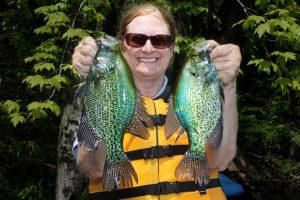Properly rigged floats can help you catch more crappie.
Bobber Rigging for Spring Crappie
Float your way to more crappies.
by Darl Black

The iconic image of springtime crappie fishing is an angler soaking bait under a bobber. But there is more to float fishing than a clip-on red & white plastic globe.
While there may be a fine distinction between a bobber and a float, for practical purposes the two terms as interchangeable. However, as with any family tree, there are branches. Use of different styles of floats (or bobbers) contribute to the success of specific presentations. With regard to functionality, there are two major branches to examine – fixed floats and slip floats.
Fixed Versus Slip
Fixed floats are ones that remain in position on the line where attached. The method of attachment may be a wire spring, retractable metal clips, a tiny peg or silicone sleeves. The major drawback is the end-over-end tumbling that happens with each cast.
On the other hand, slip floats are designed to move up and down the line with the depth setting determined by placement of a bobber stop; the stop is small enough to pass through rod guides and flexible enough to wind on the spool.
A bobber stop is installed prior to the float being threaded onto the line. The most popular commercial one is a stop knot; fine diameter braided line is tied over a small piece of hollow plastic straw which is slipped onto the line.
The knot is pulled off the straw onto the line, then moved up the line to the desired depth setting. The tag ends of the knot are pulled tight and trimmed – but not too close. A small bead placed on the line between the bobber stop knot and the sliding bobber prevents the hollow stem of the bobber from sliding past the knot.
When I employ a bobber presentation, a slip float is used roughly 70% of the time. The huge advantage is castablity. With the slip float nestled next to the jighead or split-shot a smoother, longer and more accurate cast is possible. Upon landing, the weight of the jig or split-shot pulls line through the float until the float encounters the bead and stop knot.
Changing the depth setting is accomplished simply by sliding the knot up or down the line, and then retightening by pulling the tag ends.
The Thill Crappie Cork is the one I use most often, either the 1/16 or 1/8-ounce model depending on jig weight. Regardless of which brand you use, be sure it is properly balanced with additional split-shot as needed so the float stands erect with the body partially submerged.
However, a fixed (or pegged) float can play an important role in certain presentations. If a float is used to keep a jig at a precise depth above submerged weeds or wood cover during a steady retrieve, that chore falls to a fixed float.
Situations for Springtime Rigs
In Northwest Pennsylvania our earliest open water crappie bite happens shortly after ice out in late March. Black crappie quickly moves into warming backwater bays with either wood cover or remnant vegetation. Water depth at these sites ranges between 2 and 5 feet. Typically live larval baits (i.e. maggots, wax worms) or small minnows are used to tip a 1/32-ounce tube jig.
A float is employed to keep the bait off the mucky bottom while slowing nudging the bait back to the boat. With water no greater than 5 feet, a fixed float on 6-pound monofilament line is a satisfactory option for fishing around submerged stumps, laydowns or above decayed milfoil beds. Due to the light weight of the jig, I often use a weighted bobber (either fixed or slip) to make longer casts.

Other crappie position themselves in remnants of pad beds (lily, spatterdock, lotus) thereby making bobber presentation a risky business. If 6-pound mono is used, every time a hook becomes snagged in a fibrous pad stock the line will likely break before it is pulled free. Therefore, when fishing pad beds it’s a good idea to use braided line from reel to bait. With the diameter of 4-pound mono, 10-pound braid is strong enough to rip most hooks free thereby saving your float.
Later in the spring when some black crappie often returns to emerging pad beds to spawn, braided line shines again in preventing break-offs. After the ice-out bite, I also employ braided line as my main line when casting floats to laydowns for prespawn, spawning or post-spawn crappie in order to prevent loss of slip floats.
Using a spool filled with 10-pound braid, I slip on the stop knot, bead and sliding bobber. Then tie on a small swivel. Next a 10-inch leader of 6-pound monofilament to which a 1/16-ounce jig with a Bobby Garland Baby Shad has been attached. Or you can use a live minnow if you wish. If snagged, the six-pound line breaks before the braid pulls apart the wood cover – which is attaching crappie to the spot to begin with.
Also, during the post-spawn in early June, crappie often hold on the edges a weedbed or among the stalks of milfoil (or other similar vegetation). A slow tantalizing retrieve of a small soft swimbait – such as Brewer Crappie Grub or Bobby Garland Swimming Minnow – on a 1/16-ounce jighead is an option to consider.
I incorporate a float to keep the jig at a precise level above the submerged weeds during the retrieve. This is where fixed floats shine. A 1-inch egg-shaped Plastilite Bobber or a Adjust-A-Bubble (with an internal silicone sleeve which is twisted to grab the line) are two choices.
Now go fish!

